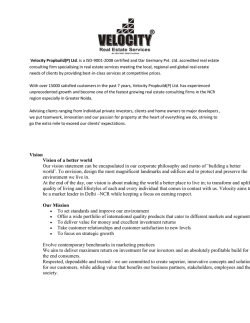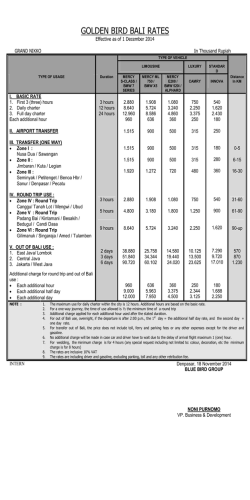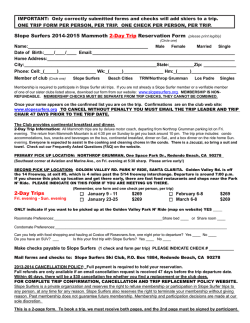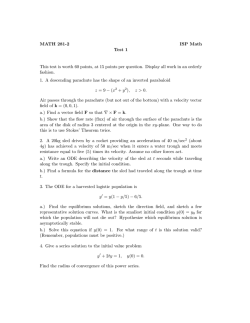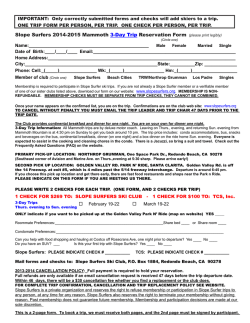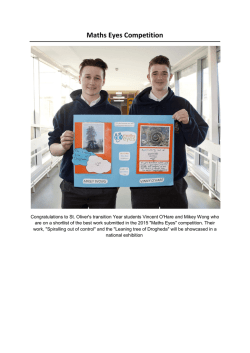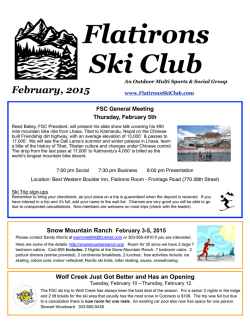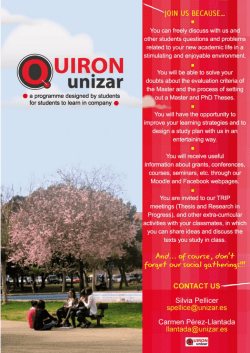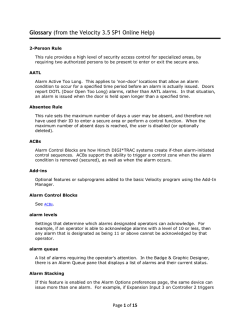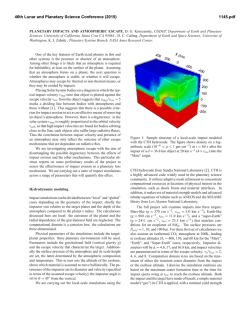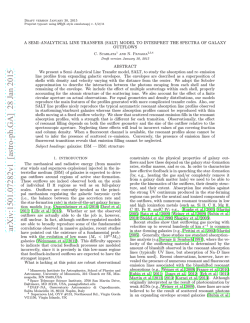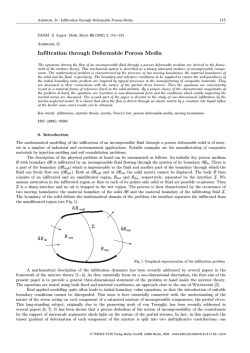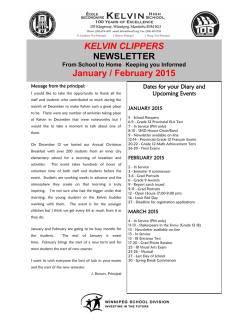
Assignment 1 Solutions(PDF)
Homework 1 Solutions 1. [10 points] A person travels by car from one city to another with different constant speeds. She drives 30.0 min at 80.0 km/h, 12.0 min at 100 km/h, and 45.0 min at 40.0 km/h and spends 15.0 min eating lunch and buying gas. a. Determine the average speed for the trip. b. Determine the distance between the initial and final cities along the route. Answer: To determine the average speed, we need to determine the total distance traveled and the total time of the trip. The total time of the trip is 𝑡𝑇𝑂𝑇𝐴𝐿 = 30.0 𝑚𝑖𝑛 + 12.0 𝑚𝑖𝑛 + 45.0 𝑚𝑖𝑛 + 15.0 𝑚𝑖𝑛 = 102 𝑚𝑖𝑛 = 1.7 ℎ To determine the total distance traveled during the trip, we can split the total trip into three smaller trips. For trip I, the person drives 30.0 min (or 0.5 hours) at 80.0 km/h. This implies that her displacement for this trip is ∆𝑥1 = 𝑣1 ∆𝑡1 = (80.0 𝑘𝑚 ) (0.5 ℎ) = 40.0 𝑘𝑚 ℎ For trip II, the person drives 12.0 min (or 0.2 hours) at 100 km/h. This implies that her displacement for this trip is ∆𝑥2 = 𝑣2 ∆𝑡2 = (100 𝑘𝑚 ) (0.2 ℎ) = 20.0 𝑘𝑚 ℎ For trip III, the person drives 45.0 min (or 0.75 hours) at 100 km/h. This implies that her displacement for this trip is ∆𝑥3 = 𝑣3 ∆𝑡3 = (40.0 𝑘𝑚 ) (0.75 ℎ) = 30.0 𝑘𝑚 ℎ For trip IV, the person is at rest so ∆𝑥4 = 0 𝑘𝑚. Thus, the total distance traveled during the trip is ∆𝑥𝑇𝑂𝑇𝐴𝐿 = ∆𝑥1 + ∆𝑥2 + ∆𝑥3 + ∆𝑥4 = 40.0 𝑘𝑚 + 20.0 𝑘𝑚 + 30.0 𝑘𝑚 + 0 𝑘𝑚 = 90.0 𝑘𝑚 The average speed of the trip is given by 𝑣̅ = ∆𝑥𝑇𝑂𝑇𝐴𝐿 90.0 𝑘𝑚 𝑘𝑚 𝑚 = = 52.9 = 14.69 𝑡𝑇𝑂𝑇𝐴𝐿 1.7 ℎ ℎ 𝑠 2. [10 points] Colonel John P. Stapp, USAF, participated in studying whether a jet pilot could survive emergency ejection. On March 19, 1954, he rode a rocket-propelled sled that moved down a track at a speed of 632 mi/h (see below). He and the sled were safely brought to rest in 1.40 s. Determine in SI units the negative acceleration he experienced. Answer: By definition, acceleration is defined as the change in velocity over a given time period. To write the acceleration in SI units, we must convert the speed to m/s. Thus 632 𝑚𝑖 1ℎ 1609 𝑚 ×( )×( ) = 282.5 𝑚/𝑠 ℎ 3600 𝑠 1 𝑚𝑖 Therefore, the negative acceleration experienced by Colonel John P. Stapp is given by 𝑚 𝑚 ∆𝑣 𝑣𝑓 − 𝑣𝑖 0 𝑠 − 282.5 𝑠 𝑎= = = = −201.8 𝑚/𝑠 2 ∆𝑡 ∆𝑡 1.40 𝑠 3. [10 points] The velocity vs. time graph for an object moving along a straight path is shown below. a. Describe the motion of the object from 0 s to 20 s. b. Find the average acceleration of the object during the intervals: (i) 0 to 5.0 s, (ii) 5.0 to 15.0 s, and (iii) 0 to 20 s. c. Find the instantaneous acceleration at 2.0 s, 10.0 s, and 18.0 s. Answer: (a) Let’s assume that the object moves from left to right. According to the velocity vs. time graph, the object travels to the left at 8 m/s for 5 s. After 5 s, the object slows down until it reaches a velocity of 0 m/s. After 10 s, the object changes directions and speeds up to the right until it reaches a velocity of 8 m/s at 15 s. After 15 seconds, the object maintains a constant velocity of 8 m/s to the right. (b) The average acceleration is defined as the total change in velocity over a given time period. During interval (i), the velocity does not change and thus the average acceleration is 0 𝑚/𝑠 2 . During interval (ii), the velocity does change and thus, the average acceleration is calculated as 𝑚 𝑚 𝑣(𝑡 = 15 𝑠) − 𝑣(𝑡 = 5 𝑠) 8 𝑠 − (−8 𝑠 ) 𝑎̅ = = = 1.6 𝑚/𝑠 2 15 𝑠 − 5 𝑠 10 𝑠 During interval (iii), the average acceleration is calculated as 𝑚 𝑚 𝑣(𝑡 = 20 𝑠) − 𝑣(𝑡 = 0 𝑠) 8 𝑠 − (−8 𝑠 ) 𝑎̅ = = = 0.8 𝑚/𝑠 2 20 𝑠 − 0 𝑠 20 𝑠 (c) The instantaneous acceleration at a given time is defined as the slope of the tangent line of the velocity vs. time graph at a given time. At 𝑡 = 2.0 𝑠 and at 𝑡 = 18.0 𝑠, we see that the tangent line to the velocity vs. time curve is horizontal, indicating a zero slope. Thus, the instantaneous acceleration at 𝑡 = 2.0 𝑠 and 𝑡 = 18.0 𝑠 is 0 m/s2. At 𝑡 = 10.0 𝑠, we see that the slope of the tangent line is the same as the slope of the secant line connecting the points 𝑡 = 5 𝑠 and 𝑡 = 15.0 𝑠. This indicates that the instantaneous acceleration at 𝑡 = 10.0 𝑠 is the same as the average acceleration in the interval 5.0 s to 15.0 s, which was given in part (b). Therefore, we have 𝑎(𝑡 = 10.0 𝑠) = 𝑎̅5→15 = 1.6 𝑚 𝑠2 4. [10 points] Two cars travel in the same direction along a straight highway, one at a constant speed of 55 mi/h and the other at 70 mi/h. a. Assuming they start at the same point, how much sooner does the faster car arrive at a destination 10 mi away? b. How far must the faster car travel before it has a 15-min lead on the slower car? Answer: (a) Let v1 be the velocity of the slower car and v2 be the velocity of the faster car. Thus, v1 = 55 mi/h and v2 = 70 mi/h. To determine how much sooner the faster car arrives, we determine the time necessary for both cars to travel 10 miles. Since both cars are moving at constant speeds, then by definition, 𝑡1 = ∆𝑥 10 𝑚𝑖 = = 0.18 ℎ 𝑣1 55 𝑚𝑖/ℎ 𝑡2 = ∆𝑥 10 𝑚𝑖 = = 0.14 ℎ 𝑣2 70 𝑚𝑖/ℎ Therefore, the faster car arrives 0.04 hours or 144 seconds sooner than the slower car. (b) Since both cars are traveling at constant speeds, then the faster car will be 2.4 minutes ahead for every 10 miles. To determine how far the faster car must travel before it has a 15-min lead, we can use a ratio (15 𝑚𝑖𝑛) × (10 𝑚𝑖) 2.4 𝑚𝑖𝑛 15 𝑚𝑖𝑛 = → ∆𝑥 = = 62.5 𝑚𝑖 = 100584 𝑚 10 𝑚𝑖𝑙𝑒𝑠 ∆𝑥 2.4 𝑚𝑖𝑛 Therefore, the faster car must travel approximately 62.5 miles (or 100562.5 m) in order to have a 15-min lead on the slower car. 5. [10 points] To qualify for the finals in a racing event, a race car must achieve an average speed of 250 km/h on a track with a total length of 1600 m. If a particular car covers the first half of the track at an average speed of 230 km/h, what minimum average speed must it have in the second half of the event in order to qualify? Answer: As the car travels the first half of the track (i.e. a distance of 800 m) at an average speed of 230 km/h (or 63.8 m/s), the time of travel is given by 𝑡1 = ∆𝑥1 800 𝑚 = = 12.5 𝑠 𝑣1 63. 8 𝑚/𝑠 In order to qualify for the racing event, the car must achieve an average speed of 250 km/h (or 69.4 m/s) on a track with a total length of 1600 m. This means that the total time necessary to travel the entire track is 𝑡𝑇𝑂𝑇𝐴𝐿 = ∆𝑥𝑇𝑂𝑇𝐴𝐿 1600 𝑚 = = 23.04 𝑠 𝑣̅ 69.4 𝑚/𝑠 The maximum time necessary to cover the second half of the event in order to qualify must be 𝑡2 = 𝑡𝑇𝑂𝑇𝐴𝐿 − 𝑡1 = 23.04 𝑠 − 12.5 𝑠 = 10.54 𝑠 Therefore, the minimum average speed that is necessary to travel the second half of the track 𝑣̅ = ∆𝑥2 800 𝑚 𝑚 𝑘𝑚 = = 75.90 = 273.2 𝑡2 10.54 𝑠 𝑠 ℎ Bonus: [5 points] A tortoise can run with a speed of 0.10 m/s, and a hare can run 20 times as fast. In a race, they both start at the same time, but the hare stops to rest for 2.0 minutes. The tortoise wins by 20 cm. How long does the race take? What is the length of the race? Answer: Let Δx1 be the total displacement of the tortoise and let Δx2 be the total displacement of the hare. Since the tortoise wins the race by 20 cm, this implies that, at the time that the race ends, we have ∆𝑥1 = ∆𝑥2 + 0.20 𝑚 (1) Let t1 be the time that the tortoise spends running and let t2 be the time that the hare spends running. Since the hare stops to rest for 2.0 minutes, this implies that 𝑡1 = 𝑡2 + 120 𝑠 (2) Also since both tortoise and the hare run at constant speeds, then by definition ∆𝑥1 = 𝑣1 𝑡1 ∆𝑥2 = 𝑣2 𝑡2 (3) (4) We can use these relationships to determine how long the race took. Substituting (1) and (2) into (3) gives ∆𝑥2 + 0.20 𝑚 = 𝑣1 (𝑡2 + 120 𝑠) (5) Substituting (5) into (4) gives 𝑣1 (𝑡2 + 120 𝑠) − 0.20 𝑚 = 𝑣2 𝑡2 𝑣1 (120 𝑠) − 0.20 𝑚 = (𝑣2 − 𝑣1 )𝑡2 Since the hare runs 20 times as fast as the tortoise, this means that 𝑣2 = 20𝑣1 = 20(0.1 𝑚/𝑠) = 2 𝑚/𝑠. Solving for 𝑡2 gives 𝑡2 = 120𝑣1 − 0.20 (120 𝑠)(0.10 𝑚/𝑠) − 0.20 𝑚 = = 6.21 𝑠 𝑣2 − 𝑣1 2.0 𝑚/𝑠 − 0.1 𝑚/𝑠 Therefore the total time for the race is 𝑡1 = 𝑡2 + 120 𝑠 = 126.2 seconds. The length of the race can be determined by (4) ∆𝑥2 = 𝑣2 𝑡2 = (2.0 𝑚/𝑠)(6.21 𝑠) = 12.42 𝑚 Therefore the length of the race is 12.6 meters.
© Copyright 2026
